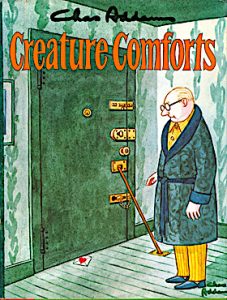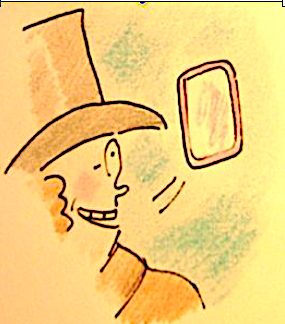Stoliar’s Addams Birthday Salute
With Steve Stoliar‘s permission, I’m showing you his Addams Birthday tribute in its entirety (as seen on Facebook):
 On this day in 1912, Charles Samuel Addams was born in Westfield, New Jersey. His macabre cartoons festooned copies of “The New Yorker” magazine from 1933 until his death in 1988 and – of course – spawned “The Addams Family” in all of its various animated and live-action permutations.
On this day in 1912, Charles Samuel Addams was born in Westfield, New Jersey. His macabre cartoons festooned copies of “The New Yorker” magazine from 1933 until his death in 1988 and – of course – spawned “The Addams Family” in all of its various animated and live-action permutations.

 Charles Addams (Born in Westfield, New Jersey, January 7, 1912. Died September 29, 1988, New York City. New Yorker work: 1932 – 1988 * the New Yorker has published his work posthumously. One of the giants of The New Yorker’s stable of artists. Key cartoon collections: While all of Addams’ collections are worthwhile, here are three that are particular favorites; Homebodies (Simon & Schuster, 1954), The Groaning Board (Simon & Schuster, 1964), Creature Comforts (Simon & Schuster, 1981). In 1991 Knopf published The World of Chas Addams, a retrospective collection. A biography, Charles Addams: A Cartoonist’s Life, by Linda Davis, was published in 2006 by Random House. Visit the Addams Foundation website for far more information : charlesaddams.com
Charles Addams (Born in Westfield, New Jersey, January 7, 1912. Died September 29, 1988, New York City. New Yorker work: 1932 – 1988 * the New Yorker has published his work posthumously. One of the giants of The New Yorker’s stable of artists. Key cartoon collections: While all of Addams’ collections are worthwhile, here are three that are particular favorites; Homebodies (Simon & Schuster, 1954), The Groaning Board (Simon & Schuster, 1964), Creature Comforts (Simon & Schuster, 1981). In 1991 Knopf published The World of Chas Addams, a retrospective collection. A biography, Charles Addams: A Cartoonist’s Life, by Linda Davis, was published in 2006 by Random House. Visit the Addams Foundation website for far more information : charlesaddams.comFound! The “Talking-Animal” Cartoon Issue
Perhaps I shouldn’t have used an exclamation point in the headline for this post. I’ve a feeling that I may be one of the few individuals on the planet who finds this discovery all that exciting. So be it!
 Some backstory is necessary: Many years ago — about fifty in fact — when I was in college, I bought my first copy of Brendan Gill’s Here At The New Yorker; I went through it with a mental microscope, examining every word and photograph. One passage in the book presented a small unsolved mystery (to me). Gill wrote:
Some backstory is necessary: Many years ago — about fifty in fact — when I was in college, I bought my first copy of Brendan Gill’s Here At The New Yorker; I went through it with a mental microscope, examining every word and photograph. One passage in the book presented a small unsolved mystery (to me). Gill wrote:
“Once, Geraghty [James Geraghty: The New Yorker‘s art editor from 1939-1973] mentioned to me that the art ‘bank’ contained a deplorably high number of jokes featuring conversations between animals. I proposed that the artwork of an entire issue of the magazine be devoted to talking-animal jokes, thus reducing the bank and just possibly causing our readers to lose their minds. My proposal was accepted, the issue came out, and as far as the magazine could judge, the prank went largely unobserved.”
The mystery (to me) was, of course, which entire issue was “devoted to talking-animal jokes.” Although I’ve been through every issue of the magazine, my interests through the years were often focused on finding something specific (a particular cartoon, or an article). But I do sometimes just grab a bound volume of ancient New Yorkers and sit with it. I had hoped that one day I’d wander in to an issue and realize I’d found Gill’s “talking-animal” issue. Well, it only took half-a-century, but it finally happened.
The issue of August 29, 1959 contains 14 cartoons. Not a human in sight in any of them (some of the cartoons feature insects or sea creatures or what have you). I’d love to show you the cartoons, but reproducing an issue’s worth is a no-no. Instead I’ll list the cartoonist, and ever-so-briefly tell you what animals or non-animals are featured:
The very first cartoon — and a clue as to this issue being different, appears on The Talk Of The Town page. That page, at that time, was usually reserved for Otto Soglow’s spot drawings. But not this time: what you see is an Ed Fisher owl — it’s a caption-less drawing. I’m showing it in the hope that a reader will explain exactly what the owl’s pendant signifies. (I knew Ed fairly well — one of the nicest cartoonists ever. I’m sure, if he was still with us, he wouldn’t mind my showing his cartoon here).
 Next, a talking elephant cartoon by Alain; a talking bear cartoon by James Stevenson; micro-organisms (?) by Dana Fradon; two pages of cats by Steinberg; vultures by Everett Opie; evolving sea creatures by Frank Modell; a giraffe by Kenneth Mahood; a school of fish by Dana Fradon; a dog by Ton Smits; Noah’s Ark by James Stevenson; a couple of octopus by Frank Modell; caterpillars (centipedes?) by Ton Smits; turtles by Frank Modell.
Next, a talking elephant cartoon by Alain; a talking bear cartoon by James Stevenson; micro-organisms (?) by Dana Fradon; two pages of cats by Steinberg; vultures by Everett Opie; evolving sea creatures by Frank Modell; a giraffe by Kenneth Mahood; a school of fish by Dana Fradon; a dog by Ton Smits; Noah’s Ark by James Stevenson; a couple of octopus by Frank Modell; caterpillars (centipedes?) by Ton Smits; turtles by Frank Modell.
So there you have it — a found footnote in the magazine’s cartoon history.
_________________________________________________________________
The Tilley Watch Online, January 1 – 5, 2024
An end of the week listing of New Yorker artists whose work has appeared on newyorker.com features
The Daily Cartoon: Anjali Chandrashekar, Asher Perlman, Joe Dator, Farley Katz, Bob Eckstein.
_____________________________________________________________________




The owl’s pendant looks like a Phi Beta Kappa key to me.
I really enjoy both your blog and your wife’s!
Yes. It’s a wise owl.
I’m one of the other few individuals on the planet who finds this discovery exciting. I’ve wondered about the animal issue since I read Gill’s book (also many years ago) and I’m thrilled to have now seen it via the online archive. Thank you